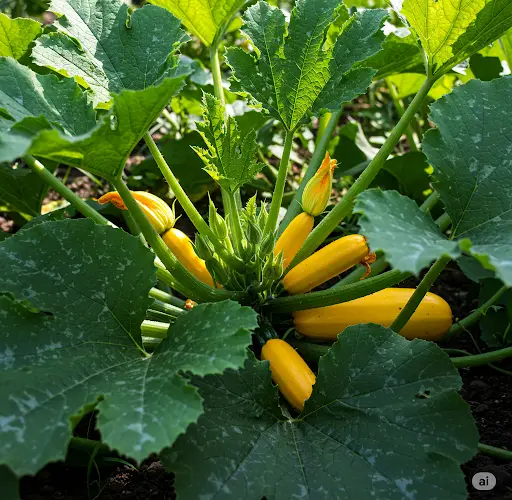Zucchinis are typically one of the most productive vegetables in the garden. But sometimes, instead of growing into plump, green fruits, they begin to turn yellow, shrivel, and rot—often while still small. This frustrating issue can affect even healthy-looking plants, leaving gardeners wondering what went wrong.
Fortunately, most causes of yellowing and rotting zucchinis are easy to identify and fix. Here’s a detailed look at the common reasons behind this problem—and what you can do to prevent it for a healthy, abundant harvest.
1. Poor Pollination
One of the most common reasons zucchinis turn yellow and rot early is incomplete or poor pollination. Zucchini plants produce separate male and female flowers. For the female flower to develop into a fruit, pollen from the male flower must be transferred—usually by bees or other pollinators.
If this process doesn’t happen correctly, the fruit begins to develop but quickly turns yellow and dies off.
How to Fix It:
-
Encourage pollinators: Plant bee-friendly flowers nearby, avoid using insecticides, and ensure the garden is pollinator-friendly.
-
Hand-pollinate if necessary: Use a small brush or cotton swab to transfer pollen from the male flower (which has a thin stem) to the female flower (which has a swollen base that looks like a mini zucchini). Do this in the morning when flowers are open.
2. Blossom End Rot
Another frequent culprit is blossom end rot, which causes the bottom end of the zucchini (opposite the stem) to turn brown or black and mushy. This is not a disease but a physiological disorder caused by a calcium imbalance, often linked to inconsistent watering or rapid growth.
How to Fix It:
-
Water consistently: Zucchinis need regular moisture—about 1–1.5 inches of water per week. Avoid letting the soil dry out completely or stay soggy.
-
Mulch: Apply mulch around the base of the plant to retain soil moisture and prevent fluctuations.
-
Improve calcium availability: While adding calcium is rarely needed in well-balanced soils, you can test your soil to confirm calcium levels. Avoid over-fertilizing with nitrogen, as it can interfere with calcium uptake.
3. Overwatering or Poor Drainage
Too much water can cause developing zucchini to rot. Overly wet soil reduces oxygen to the roots, stressing the plant and leading to fruit rot, especially at the blossom end.
How to Fix It:
-
Check drainage: Make sure your garden bed or container drains well. Raised beds are ideal for zucchini.
-
Water deeply but infrequently: Let the top inch of soil dry out before watering again.
-
Avoid watering from above: Use a soaker hose or water at the base to keep the leaves and fruit dry, reducing the chance of fungal issues.
4. Fungal or Bacterial Diseases
Some zucchinis rot due to fungal infections like gray mold (Botrytis) or anthracnose, or bacterial rots. These diseases thrive in humid conditions and can affect both leaves and fruit.
Symptoms may include:
-
Soft, mushy spots on the fruit
-
Mold or mildew on leaves
-
Yellowing and sudden rotting of fruits
How to Fix It:
-
Improve air circulation: Space plants properly and prune lower leaves if needed to reduce humidity around the plant.
-
Water in the morning: This allows foliage to dry out before evening.
-
Remove infected fruits or leaves promptly to prevent spread.
-
If needed, apply an organic fungicide such as copper-based sprays or neem oil (follow instructions carefully).
5. Lack of Nutrients
Zucchinis are heavy feeders and may not develop properly if the soil lacks essential nutrients. A deficiency, particularly in potassium or phosphorus, can lead to poor fruit development, yellowing, and rot.
How to Fix It:
-
Feed your plants with a balanced, slow-release vegetable fertilizer (e.g., 5-10-10 or 10-10-10) at the start of flowering.
-
Supplement with compost or organic plant feed during the growing season.
-
Avoid too much nitrogen, which promotes leafy growth at the expense of fruit production.
6. Harvesting Too Late
If zucchinis are left too long on the plant, they may become overripe and start to yellow and soften, especially in warm, humid conditions.
How to Fix It:
-
Harvest regularly when zucchinis are about 6–8 inches long for the best flavor and texture.
-
Picking fruits promptly encourages the plant to produce more.
Final Tips to Prevent Zucchini Rot
-
Rotate crops each year to avoid soil-borne diseases.
-
Monitor for pests such as squash vine borers and aphids, which can stress plants and contribute to rot.
-
Keep the area clean of fallen leaves and fruit to reduce disease risk.
With consistent care and close attention to pollination, watering, and nutrition, your zucchini plants can bounce back and produce healthy, vigorous fruits throughout the season. Don’t be discouraged—many gardeners face these issues, and the solutions are usually simple once identified.



